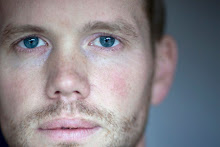The HOPE DEBATE consisted of a series of three public interviews, where Elke van Campenhout discussed with James Beckett, performers from Lone Twin Theatre, and Dries Verhoeven the possibility of hope as an artistic practice. The interview with James was conducted on the set design of his performance Zakłady na Życie (Plant Life). With the his characteristic clarity, he explained his approach to his work: “A healthy intellectual will maintain a curiosity for everything. But when it comes to creative work, it helps to limit yourself and make very specific choices in order to develop a style.” In the second interview, Elke approached the performers from Lone Twin in a playful way, and requested them to choose questions from a piece of paper to read to one another. On the third one, she and Dries Verhoeven were both blindfolded, as they explored the complexities of hope within intercultural communication, as exemplified by the performance Life Streaming from Dries Verhoeven.
Next to these debates, Branka Zgonjanin and Pere Faura, choreographers and students from the Amsterdam Masters of Choreography, interviewed Fanni Futterknecht, Joao Evangelista, Dries Verhoven, Inari Salmivaara, María Jerez Quintana, Min Kyoung Lee, and Jean Baptiste Veyret-Logerias (these last three being performers from Five People). Branka and Pere questioned their peers with attentiveness and curiosity, asking them to narrate their working processes and to tackle the often complex issues raised by their work.
On Friday the 28th, the 17th PSi (Perfromance Studies International) conference was oficially launched. Maaike Bleeker, one of the conference directors, announced a comprehensive program for next year. She related the story of Giulio Camillo, a 16th century philosopher, that intended to create a Memory Theatre that could contain all the memories of mankind. Contemporary commentators often see a link between this dream and the promises of the internet as a memory machine. The conference, that will bear the title Camillo 2.0, will revolve around the concepts of memory, technology and experience. These will be explored through performances, lectures, and shifts (“hybrid program components introduced by participants or initiated by the organizers which pave the way to unconventional types of presentations”). The launch of the conference was fittingly accompanied by a a talk from Frederik LeRoy on the political implications of “reenacment” as a way to keep history alive and by a presentation of Woonmachine, and installation/performance by Belgian arquitect Laurent Liefhooge that will be part of next year's prorgram. The PSi conference will take place from the 25th until the 29th of May 2011 during the next edition of Festival a/d Werf.






